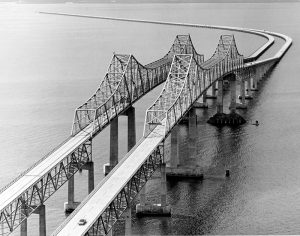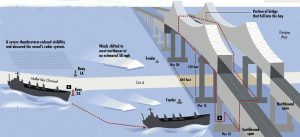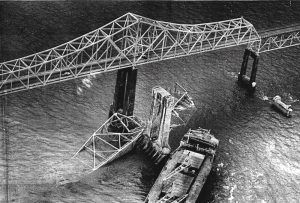The first bridge across Tampa Bay connecting Rubonia, FL, with St. Petersburg, FL, opened on September 6, 1954. The main structure was a steel cantilever span with a length of 1,584 feet built by the Virginia Bridge & Iron Company. It replaced a ferry from Point Pinellas on the southerly side of St. Petersburg to Piney Point just north of Rubonia. There were two flanking deck truss spans of 250 feet 3 inches on each side, followed by low-level deck spans. A second parallel span of the same dimensions was built just to the west in 1969 but did not open until 1971 due to foundation problems. This provided two lanes in each direction, and the road became I-275, with the old bridge handling northbound traffic and the newer bridge handling southbound traffic. The total length of the central bridge was approximately 4.4 miles, and the total length of the entire project was 14 miles.

The main shipping lane from the Gulf of Mexico to the bay was called the Mullet Key Channel. It was dredged to a depth of about 35 feet and passed under the main span of the cantilever section of the Tampa Bay bridge. The central span consisting of two cantilever arms and a suspended span, had a center-to-center length of 864 feet, and provided a horizontal clearance of 800 feet and a vertical clearance of 155 feet. The two anchor arms were 360 feet long, and the cantilever arms 252 feet. The suspended span was 360 feet in length.

The two main shipping lane piers had fender protection. The two anchor arm piers had no protection, as they were outside the shipping channel. The anchor piers, consisting of two concrete columns mounted on a wide concrete base (plinth), were smaller than the two main towers as they carried a compressive load from the flanking span and a tension load from the cantilever. They were also shorter as they only came up to the lower chord of the flanking trusses.
Weather in the area was frequently volatile and, during the construction of the bridges, there were many delays. Vessels were normally not moved in dense fog and/or during strong northwest winds. Pilots were usually boarded at Egmont Key, a small island to the west of the bridge, to guide the ships into the bay. In January 1972, August 1973, May 1977, and February 1980, there were collisions of ships with the fenders of the main piers. In addition, two ships collided in the channel on January 28, 1980, near the bridge. After these collisions, repairs were made to the fender system, but no significant upgrades were made to the structure.
On May 9, 1980, this was the situation when the Summit Venture, a Liberian registered phosphate carrier ship, running empty, was steaming towards Tampa Bay. The ship, built in 1976 in Nagasaki, Japan, was 580 feet long and 86 feet wide with a displacement of 19,734 tons. Captain John Lerro boarded the ship at Egmont Key around 6:30 A.M., then checked the weather and channel traffic. At the time, there was only a slight mist in the air. He had been told another ship would be leaving the port at about the time he would be entering, so he had to be careful to avoid a collision. Lerro, who had guided over 800 ships into the bay, proceeded to guide it to the entrance to Tampa Bay. The trip’s difficulty was compounded by the shallow depth of the bay outside the shipping channel and frequently unpredictable weather. He soon had to deal with poor visibility due to fog and rain. It turned out that the other ship anchored short of the bridge to ride out the storm. What happened next can be seen in the illustration of the ship’s path.
First, a severe thunderstorm blew in from the northwest, pushing the ship, which was riding high in its unloaded condition, outside the shipping channel. Lerro sent two lookouts to the bow of the bridge when the weather turned worse. He was to make an 18° turn to the left between buoys 1A and 2A, shown in the graphic. An unpredicted strong wind came up out of the north-northwest and blew the ship farther outside the channel. In addition, the ship’s radar failed.
Lerro later testified, “It was heavy, heavy, heavy rain. The radar screen was a sheet of water. It turned yellow. You could see nothing.” He could not see the bridge until a small break in the weather caused it to come into view. He tried to stop the ship by ordering a dropping of the anchor and the reversing of its engines, but everything he attempted could not slow the ship fast enough. Yet he was moving slow enough that he could not steer the ship away from the pier. The ship hit the main pier with a glancing blow causing no damage to the bridge, but then hit the anchor span pier head-on, causing its collapse at 7:33 in the morning. When that pier failed, the weight of the cantilever caused the anchor span to lift, overloading it until it separated from the far cantilever arm, and the anchor span, cantilever arm, and suspended span dropped into the bay with a portion of the bridge landing on the bow of the ship.
On the bridge, drivers were also driving through a heavy rain shower, cutting down visibility. At the time, six cars, one truck, and a Greyhound Bus carrying 23 people fell into the bay, killing 35 people. One man in a pickup truck was the only survivor as his truck fell on the bow of the ship before falling into the bay, where the ship’s crew picked him up.
As was usual, the National Transportation Board made a study of the collapse. In addition, the Pilot Commissioners found that Lerro had “acted reasonably…and his only choice was navigating blindly through the existing weather.” Lerro was called to testify by many groups and lawyers. At one of these sessions, he was quoted as follows, “…between buoys 14 and 16, the rain was intermittently heavier and lighter with the wind blowing from the southwest. Radar was still clear, and, at buoy 16, I saw buoys 1A and 2A, signaling the turn to go through the two main spans of the Skyway. When I got two-tenths of a mile in front of 1A and 2A, a storm hit me, hit the ship, hit us. I couldn’t see the bow of the ship…the rain was swirling overhead, and the wind was gusting. When I first saw the bridge, it was on my starboard bow at a 45-degree angle dead ahead…I knew immediately you’re not supposed to see that at a 45-degree angle. I ordered full stern, the rudder hard left and dropped anchor, but it was too late. I looked up to see the right side of the ship glance off the pier. It crumbled. It looked like a bunch of cornflakes crumbling down.”
The NTSB wrote in part,
“Theoretically, a cantilever bridge structure remains stable by a system of balanced weights. The weight of the anchor arm spans balance the weight of the cantilever arm span and the suspended span, with the main channel piers acting as fulcrums and main supports. The anchor piers perform the dual functions of providing support for the anchor arm span and the steel deck truss span and of maintaining the stability of the structure’s balance. Because of these major functions of support and balance, the anchor piers are critical elements of the structure.

The mass and design of bridge piers and pier protection systems and the configuration, weight, and speed of vessels have a direct effect on the damage which may result from a collision. The bulwark and the forecastle of the SUMMIT VENTURE struck the pier column before the lower bow struck the pier crash wall. If the pier crash wall had been larger or a pier protection system had been installed at that location, the initial impact would have occurred near the waterline. Because the pier crash wall is anchored through the pier footer directly into the bay bottom and is larger and stronger than the columns, it is possible that sufficient energy might have been absorbed to reduce the vessel’s forward motion and perhaps redirect the vessel before the bulwark and forecastle struck the column. While the pier still could have been damaged, only the vessel’s mast would have struck the bridge span if the vessel had been redirected to starboard. The vessel could have passed under the bridge span if it had been redirected to port, and the damage to the bridge span might have been minimized…
Bridge owners should consider protecting existing vulnerable bridges and take particular care in pier placement in future bridge construction. The FHWA should examine this issue carefully in its review process for bridges built with Federal-aid funds.
Final resting positions, vehicle damage patterns, and witnesses’ statements indicated that the Courier pickup truck was the southernmost involved highway vehicle, and all traffic ahead of that vehicle crossed the bridge safely. The Courier pickup truck, the El Camino, and the Scirocco were definitely on the collapsed section of the bridge. The remaining five vehicles were driven off the downward-sloped bridge section and fell into the water after the bridge section had collapsed. Those five vehicles carried 32 persons…Since the bus was resting over the Fairmont and the Nova, it must have followed them off the bridge…
The bus and four sedans ran off the bridge substantially after the collapse. The time available was more than sufficient to allow the drivers to stop safely, but they were not aware of the bridge condition ahead. If a bridge span failure detection and warning system had been installed and activated, it might have alerted the drivers of those vehicles of the danger ahead, and many lives might have been saved.
Therefore, the National Transportation Safety Board recommends that the Federal Highway Administration:
- Develop standards for the design, performance, and installation of bridge span failure detection and warning systems.
- Establish criteria to evaluate the need for installing bridge span failure detection and warning systems on existing and proposed bridges.
- In cooperation with the U.S. Coast Guard, develop standards for the design, performance, and location of structural bridge pier protection systems, which consider that the impact from an off-course vessel can occur significantly above as well as below the water surface.
- In cooperation with the U.S. Coast Guard, conduct a study to determine which existing bridges over the navigable waterways of United States ports and harbors are not equipped with adequate structural pier protection.
- Use the results of the study conducted under recommendation M-81-21 to advise appropriate bridge authorities of the benefits of installing additional pier protection systems. (Class U, Priority Action) (M-81-22)”
The National Transportation Safety Board voted 3 to 2 that Lerro had been partly responsible but said that other factors, including the severe storm, had contributed to the accident. Only three members approved the recommendations, with two members not participating.
Lawsuits went on for years against the owners of the Summit Venture. The FHWA issued Technical Advisory 5140.19, Pier Protection and Warning Systems for Bridges Subject to Ship Collisions, on February 11, 1983. In the Background section, it stated,
“The increase in the occurrence of ship/bridge collisions during the past 10 years warrants additional emphasis on the need to consider protection for bridge piers as well as the installation of warning systems to alert motorists in the event of a span collapse.
The purpose of this directive is to provide guidance on these subjects to the Federal Highway Administration’s (FHWA) field offices and to State and local agencies involved with Federal-aid highway projects which cross navigable waters. This material is not regulatory but has been developed to provide additional support and emphasis for developing appropriate protective and warning systems.”
It went on to make recommendations on Motorists Warning Systems and Pier Protections. Under Pier Protections, it wrote,
“Because of the tremendous momentum achieved by modern ocean-going vessels even while traveling at low speeds in inland channels, it may be extremely difficult to retrofit some existing bridge piers with protective systems which can successfully withstand the anticipated impact loadings. For this reason, it becomes particularly important to recognize the potential hazards from ship collisions and to locate and design piers on new bridges in such a way that the risks of collision are reduced to an acceptable level.”
When the new Sunshine Skyway Bridge, a cable-stayed bridge, opened in February 1987, it was located east of the twin cantilevers with a span of 1,200 feet and a vertical clearance of 180 feet. The pier foundations had large concrete islands, called dolphins, built around each of the bridge’s six piers to absorb ship impacts. Now all bridge piers in navigable waterways must be designed to resist ship impacts. Another lesson had been learned the hard way.■
